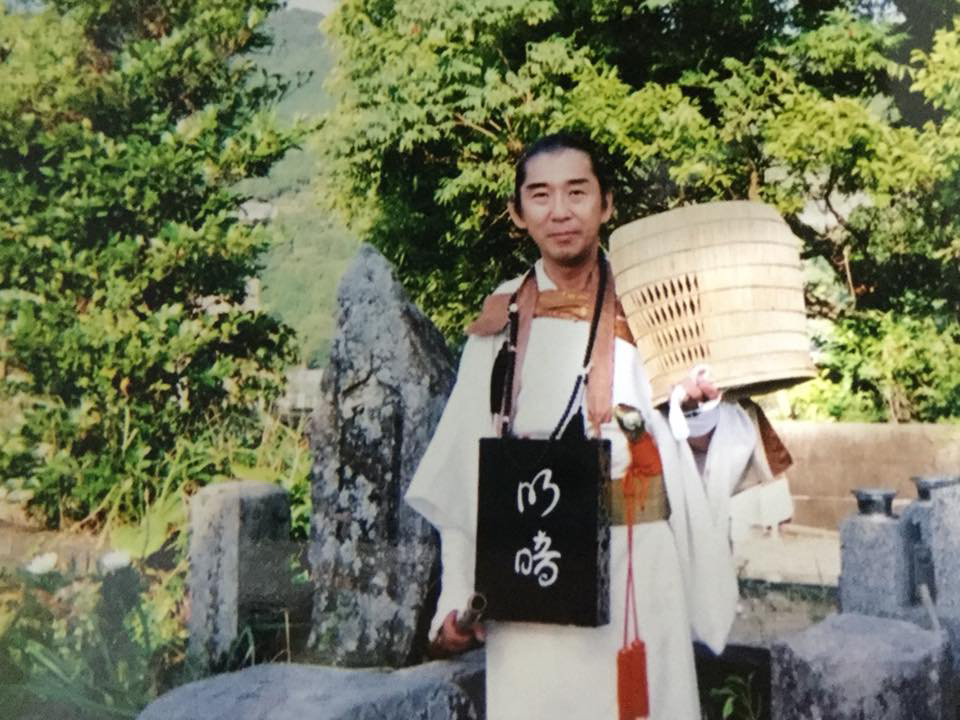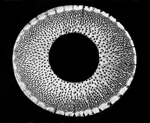|
1705: The Kōkoku Temple Ordination Platform
and Kyōto Myōan-ji's Fake "Chief Monks" -
In the Words of Makihara Ichiro, August 10, 2007
Web page updated on August 17, 2023.
Makihara Ichiro,
牧原一郎,
(a.k.a. Shin-Ichiro is a "modern" 'Komusō' of the Myōan Tradition,
however also rather critical regarding 'Komusō' history and practice as a whole.

Makihara Shin-Ichiro. Source: Facebook, August 29, 2020
On August 10, 2007, Makihara-san published an important clarification and statement on his weblog titled
"Ichiro, the Komusō, Talking about Shakuhachi and Ikkyū" - find link below, page down:
BACKGROUND:
Documents discovered and published by Nakatsuka Chikuzen,
中塚竹禅,
October 3, 1887 - May 5, 1944, during the period 1936-1939 (reprinted in 1979), testify that, in 1703,
the Kyōto Myōan Temple petitioned in formal writing addressed to the Kōkoku-ji Temple in Yura, Kii Province, present Wakayama Prefecture,
to be granted status and privileges as its sub temple, or "child temple".
Kōkoku-ji was (and still is) a sub temple of the Myōshin-ji in Kyōto, head temple of the Myōshin Branch of Rinzai Zen Buddhism.
This is the title, the headline, of Makihara-san's article:
普化宗の日本開祖法灯国師も尺八を吹けなかった。
'Fuke-shū no Nihon kaiso Hottō Kokushi mo shakuhachi o fukenakatta.'
"Hottō Kokushi, Japanese Founder of the Fuke Sect, could not even play the Shakuhachi."
Here, first, follows Makihara-san's text in Japanese, then the English translation down beneath:
紀州(和歌山県)由良の興国寺。
その開祖法灯国師心地覚心(又は学心)が普化禅(虚無僧)の日本開祖という噂は、戦国時代末から江戸時代の初め頃に創られたようだ。
しかし、興国寺側にそういう史料は全く存在しない。
京都の虚無僧寺明暗寺から江戸時代の半ば、いきなり親寺になってほしいと
手紙が来た。
興国寺としては、無視していたのだが、「然るべきお金も毎年
納めますから」との再三の要請に、親寺を引き受ける。
すると興国寺の親寺、臨済宗妙心寺派の総本山、妙心寺からクレームがついた。
「明暗寺とやらがいつのまにか興国寺の末寺になっているが聞いてないぞ」という脅しである。
これに対して興国寺は、「寺が火事で焼けて記録は有りませんが、なんでも
その昔ちょっとした関係があったようです」と苦しい弁明をしている。
明暗寺もいい加減だ。
毎年お金を納めるとか、「住職になる虚無僧はきち
んと興国寺で剃髪して得度受戒を受けます」と約束したにもかかわらず、
ちっとも実行しない。
親寺-末寺の関係はうやむやのまま歳月が過ぎた。
明暗寺が、興国寺の末寺になろうとしたのには次のような理由があった。
幕府の浪人取締りとキリシタン禁令による宗門改めである。
虚無僧寺は元々浪人の溜り場である。
葬儀を執り行うこともせず、墓地もない。
- - - "
Here, the English Translation:
"The Kōkoku Temple in Yura, Wakayama Prefecture.
Seemingly, the common talk [also: "rumour", "gossip"] that the [temple's] founder Hottō Kokushi (a.k.a. Kakushin),
was the "Japanese founder" of 'Fuke Zen' ('komusō') was created early in the Edo Era that followed after the "Warring States Period"
[of the 16th century].
However, at the Kōkoku Temple, absolutely no such sources [to confirm it] exist.
Suddenly, [about] halfway* through the Edo Period, a letter arrived from the 'Komusō' Myōan Temple in Kyōto
expressing a wish to become a sub temple [of Kōkoku-ji's].
As for Kōkoku-ji, although reluctantly, after several appeals [from Myōan-ji],
the request for sub temple status and privileges was granted*, [however only] on the condition that
"an annual amount of money (should) be paid" [by the Myōan Temple].
Thereupon, a "claim" [Jap.:
クレーム]
followed from the head temple of the Rinzai Myōshin-ji Branch,
namely the Myōshin Temple [itself], inquiring in a threatening tone:
"We have not at all heard about when Kōkoku-ji became a mother temple for the Myōan Temple!"
In reply to this, Kōkoku-ji responded,
"The temple was devastated by fire so there are no records; anyhow, it seems that there was some [mutual] relation in its past,"
the problematic explanation goes.
"Myōan-ji is in a good state, though."
Every year, it pays money, and in spite that "Komusō who are to become ‘jū-shoku’,
住職, [head monks] are having their heads properly shaved at Kōkoku-ji,
and ordained to enter the priesthood, nevertheless, there is nothing more involved."
As for mother-child temple relationships, times are hazily passing by ...
The reasons why Myōan-ji wanted to become a Kōkoku-ji sub temple are the following:
The Bakufu [Tokugawa Government] management and control of the masterless samurai [the 'rōnin']
and the Bureau of Religious Sects Inspection [Shūmon aratame-yaku] effectuation of the ban on Christianity
and the prosecution of Christian converts.
Komusō temples were, by nature, gathering places for 'rōnin', masterless samurai.
Neither did they hold funeral ceremonies, nor were there [any] graveyards [at their temples].
- - - "
* The accurate time is the period 1703 to 1705.
Link to Makihara Ichiro's weblog with the article online
|
|

